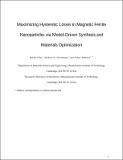Maximizing Hysteretic Losses in Magnetic Ferrite Nanoparticles via Model-Driven Synthesis and Materials Optimization
Author(s)
Chen, Ritchie; Anikeeva, Polina Olegovna; Christiansen, Michael Gary
DownloadChen_OptimizedMNP_draft_v18.pdf (1.420Mb)
PUBLISHER_POLICY
Publisher Policy
Article is made available in accordance with the publisher's policy and may be subject to US copyright law. Please refer to the publisher's site for terms of use.
Terms of use
Metadata
Show full item recordAbstract
This article develops a set of design guidelines for maximizing heat dissipation characteristics of magnetic ferrite MFe[subscript 2]O[subscript 4] (M = Mn, Fe, Co) nanoparticles in alternating magnetic fields. Using magnetic and structural nanoparticle characterization, we identify key synthetic parameters in the thermal decomposition of organometallic precursors that yield optimized magnetic nanoparticles over a wide range of sizes and compositions. The developed synthetic procedures allow for gram-scale production of magnetic nanoparticles stable in physiological buffer for several months. Our magnetic nanoparticles display some of the highest heat dissipation rates, which are in qualitative agreement with the trends predicted by a dynamic hysteresis model of coherent magnetization reversal in single domain magnetic particles. By combining physical simulations with robust scalable synthesis and materials characterization techniques, this work provides a pathway to a model-driven design of magnetic nanoparticles tailored to a variety of biomedical applications ranging from cancer hyperthermia to remote control of gene expression.
Date issued
2013-09Department
Massachusetts Institute of Technology. Department of Materials Science and Engineering; Massachusetts Institute of Technology. Research Laboratory of ElectronicsJournal
ACS Nano
Publisher
American Chemical Society (ACS)
Citation
Chen, Ritchie, Michael G. Christiansen, and Polina Anikeeva. “Maximizing Hysteretic Losses in Magnetic Ferrite Nanoparticles via Model-Driven Synthesis and Materials Optimization.” ACS Nano 7, no. 10 (October 22, 2013): 8990–9000.
Version: Author's final manuscript
ISSN
1936-0851
1936-086X